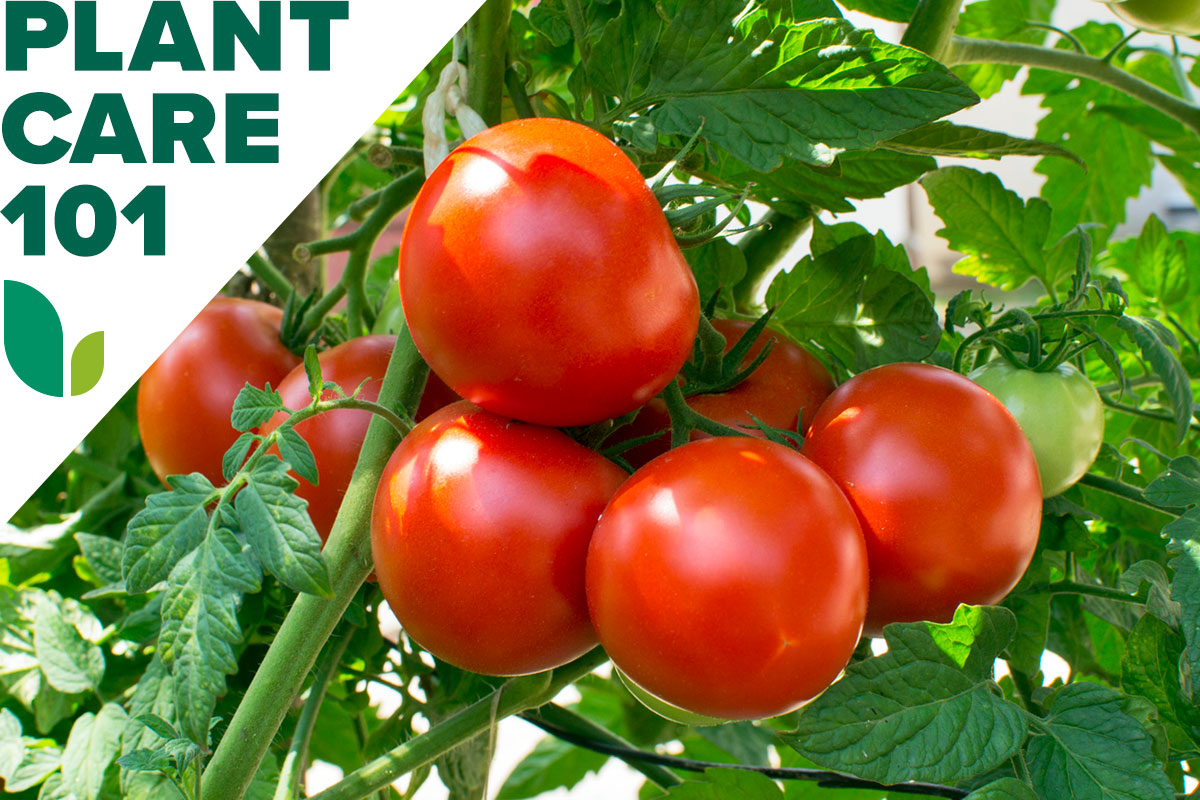

We may earn revenue from the products available on this page and participate in affiliate programs. Learn More ›
Tomatoes are the most popular vegetable in the world, so it’s not surprising that they’re one of the most frequently grown food plants. That might be because they’re relatively easy to grow. But it could be because the fruit is versatile; it’s delicious either raw or cooked in a variety of forms in numerous cuisines. Whatever the reason, tomatoes remain one of the most popular types of backyard garden produce.
While they’re known to be fairly forgiving plants, it’s not difficult to make costly mistakes when growing tomatoes. For healthy plants, higher yields, and delicious results, here’s what you need to know to learn how to grow tomatoes.
Growing Tomatoes at a Glance
Common Name: Tomato
Scientific Name: Solanum lycopersicum
Hardiness Zone: 10b to 11 (grown as annuals in all zones)
Soil: Loamy, well-drained; neutral to acidic
Light: Full sun
Water: Consistent; 1 inch per week
Food: Compost, water-soluble fertilizer high in phosphorus
Propagation: Seed or suckers
Safety: Can be harmful to humans and pets when consumed in great quantities
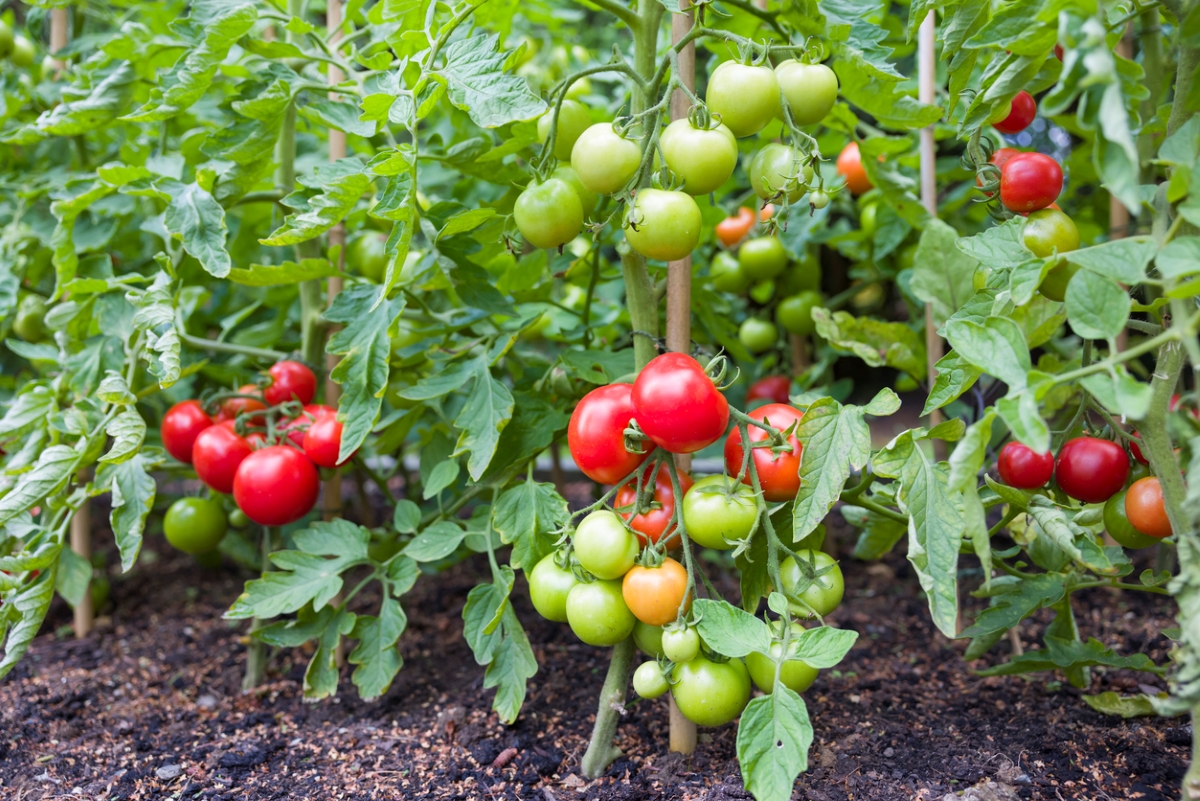
Tomato Characteristics
Botanically, tomatoes are classified as fruit because they come from a flower and contain seeds. But in 1893, the United States Supreme Court ruled that tomatoes could be classified as a vegetable based on their typical culinary applications.
Originating in Peru, where the translation of their Aztec name means “plump thing with a navel,” tomatoes (Solanum lycopersicum) are a member of the nightshade family, which includes potatoes, peppers, eggplant, and tobacco.
Tomato varieties can be either determinate or indeterminate types. Determinate tomato plants, or bush tomatoes, are smaller, usually reaching only 3 to 4 feet high. They mature early, do not need much pruning, and produce all their fruit in a 2- to 4-week period. If you’re interested in growing tomatoes in containers, determinate types are a good choice.
Indeterminate tomato plants continue to grow and produce fruit all season until frost. They benefit from pruning and require staking or some type of support.
Tomatoes can be red, yellow, orange, green, white, black, or purple. Some are solid color, while others are striped or mottled. Tomatoes can be as small as a marble or as big as a softball, and some tomato varieties are oval, while others are round.
Recommended Tomato Varieties
As you consider which types of tomatoes to grow, first think about whether determinate or indeterminate varieties make the most sense for you. Also consider whether you want early-season or late-season fruit. Some varieties are better for eating on sandwiches or in salads, while others are better for making into sauce or preserving.
Because tomatoes can take up to 140 days to mature, many gardeners start seeds indoors, buy plants already started, or choose varieties that mature faster.
Some indeterminate tomato varieties to consider:
- Early Girl: A uniform globe tomato ideal for slicing, cooking, canning, and juicing, it has a mild flavor, rarely splits, and produces a heavy, early yield.
- Big Boy: A large, round, meaty beefsteak tomato that holds its shape when sliced and features an old-fashioned flavor, it produces a high yield but is late maturing.
- Cherokee Purple: An heirloom tomato with purple tones, it features large, round, meaty fruit with green gel around the seeds and a rich, sweet flavor.
- Green Zebra: This small, globular tomato has green and yellow stripes when mature, and it offers a sweet and tart flavor that’s perfect for salsas and salads.
- Sweet 100: A fast-growing cherry tomato and heavy producer of clusters of tasty fruit smaller than a golf ball, it’s ideal for salads, hors d’oeuvres, or snacking; growing cherry tomatoes often done in containers.
- Sun Sugar: A yellow-orange cherry tomato that produces high yields of sweet fruit. “They are delicious and don’t carry the typical ‘tomato’ taste that some people don’t like,” says Ryan Scanlon, a biologist with Pittsburgh-based Q&A Landscaping. “They are sweet and add a bit of sweet to salsa, pasta sauce, and salads.”
Some determinate varieties to consider:
- Dixie Red Hybrid: This high-yielding tomato is well suited for southern gardeners looking for a flavorful slicer.
- Roma: A slender, firm, ovoid-shape plum tomato developed for canning and tomato sauce, its firm, not-so-juicy fruit also works well on pizza or as sun-dried tomatoes. Some types are determinate; others are indeterminate.
- Marglobe Improved VF: This tomato adapts well to a variety of growing conditions and is tasty as a slicer or made into sauce.
- Tycoon: A large, flavorful tomato that is disease-resistant, Tycoon does especially well in hot weather.
- Tasmanian Chocolate: A stout, sturdy dwarf tomato plant that grows 2 to 3 feet tall, Tasmanian Chocolate is well suited for container growing.
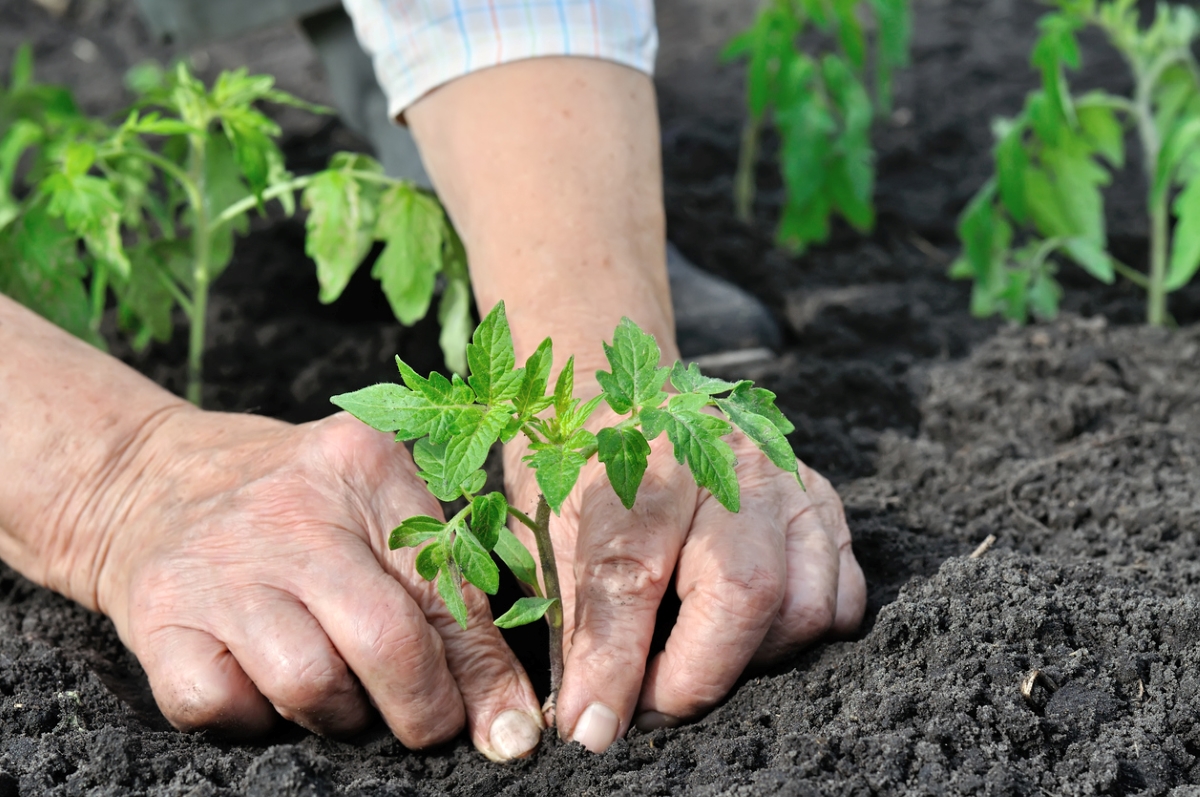
Planting Tomatoes
Tips for growing tomatoes include following proper planting instructions to ensure your plants are healthy and producing high yields of fresh, delicious fruit.
When is the best time to plant tomatoes?
Because most tomato varieties take a long time to mature, many gardeners like to get a head start by growing tomatoes indoors. If you are growing tomatoes from seed, start them 6 to 8 weeks before the last average frost in your area.
Plant tomatoes in spring when the soil warms up. Tomatoes are happiest when temperatures are between 55 degrees and 85 degrees Fahrenheit, but some varieties can’t set fruit when temperatures are above 85 degrees Fahrenheit.
Where can tomatoes grow?
Tomatoes are grown all over the world. They can be grown in traditional vegetable gardens, raised beds, containers, hot houses, and even in straw bales—pretty much anywhere they can get 6 to 8 hours of sun per day, warm temperatures, and rich, well-draining soil. As a tender, warm-season crop, these semitropical plants cannot tolerate frost.
How do you plant tomatoes?
Planting tomatoes is pretty straightforward—unless you’re planting the seedlings sideways, which encourages the growth of vertical roots to build stronger plants.
These steps are appropriate for all types of tomato plants.
- Remove the lower leaves from a hardened-off tomato plant. Set in a hole or trench so that only the top leaves are above the soil level, about 24 inches apart for bush varieties or 36 to 48 inches apart for larger types.
- Place stakes or cages near each plant.
- Backfill with soil. Add compost at this time to improve your soil’s quality.
- Water thoroughly, taking care not to get the tomato plant’s foliage wet, as that can lead to fungus growth.
- Mulch with straw or wood chips to reduce the spread of leaf diseases.
Can you grow tomatoes in containers?
Growing tomatoes in pots is possible, especially if you choose determinate varieties that remain compact. Use a container that’s at least 14 inches in diameter to allow for root development, place it in a spot that gets a minimum of 8 hours of sun each day, and fill it with soil designed for container growing. Be sure to include a trellis or some type of support and make sure the plant gets regular watering and a balanced fertilizer.
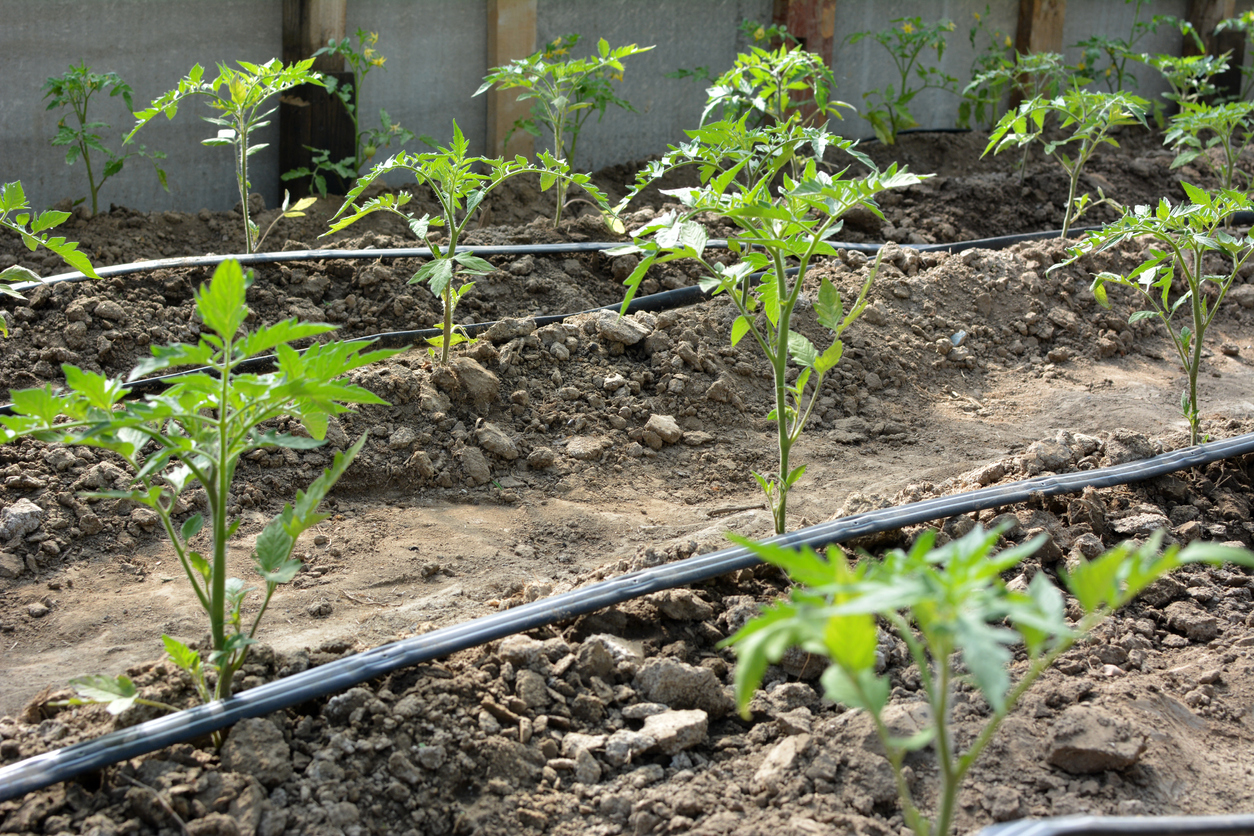
Watering Tomato Plants
“Each week, your tomato plants should be getting about 2 inches of water,” says Jeremy Yamaguchi, founder and former CEO of Lawn Love. If they’re not getting rainwater, he says that irrigating them three or four times per week will suffice. “However, during the hottest days of the summer, your tomato plants may need daily watering to stay healthy,” he adds. Consistent watering produces the best tomatoes.
To reduce the chance of fungal disease due to wet foliage, water tomatoes at the soil level using a drip feeder or soaker hose. This also reduces evaporation, while mulching can help to retain soil moisture.
Fertilizing Tomatoes
Tomatoes are heavy feeders and can almost certainly benefit from the right kind of fertilizer applied at specific times.
Apply a fertilizer high in nitrogen when planting your tomato plant, and then, when the plant begins setting fruit, apply a fertilizer that’s higher in phosphorus and lower in nitrogen to stimulate flowering and fruiting over foliage.
Pruning and Supporting Tomato Plants
Suckers, which grow in the “V” between the main stem and its branches, should be pinched off on indeterminate tomato plants because they tend to be spindly and produce inferior fruit. Some gardeners use the Missouri pruning method, which removes only the tip of the sucker; the leaves left on the plant help protect developing fruit from sunburn. If the suckers are big, it’s also less of a shock to the plant than removing them entirely.
For determinate tomato plants, prune suckers only at the bottom of the plant below the lowest flower cluster. Use sharp tools to prune tomatoes, and don’t prune when the plants are wet.
All tomato plants need support from cages, stakes, trellises, or string. Loosely tie the vines to these structures to encourage vertical growth.
Propagating Tomatoes
While most gardeners either start tomatoes from seed indoors or buy seedlings to plant directly in the garden, it is possible to propagate tomatoes from existing plants by taking cuttings. Remove the leaves from the unwanted suckers that you should be removing from healthy plants anyway, place them in water in a sunny spot, wait for roots to develop (about 3 to 4 weeks), and then plant. You can also skip the water step and plant suckers directly in the ground. Roots will grow on the portion of the plant that is underground.
Safety Considerations
As part of the nightshade family, tomato leaves and stems contain toxins that can be harmful if ingested in significant quantities—particularly to dogs and cats, but also to some humans.
Tomatoes produce solanine, a toxic alkaloid, to help ward off pests. Found in leaves, stems, and unripe fruit, it can cause nausea, vomiting, diarrhea, headaches, sweating, drowsiness, or change in heart rate and blood pressure.
They also produce tomatine, which, when consumed in significant quantities, can cause gastrointestinal problems, liver damage, or death.
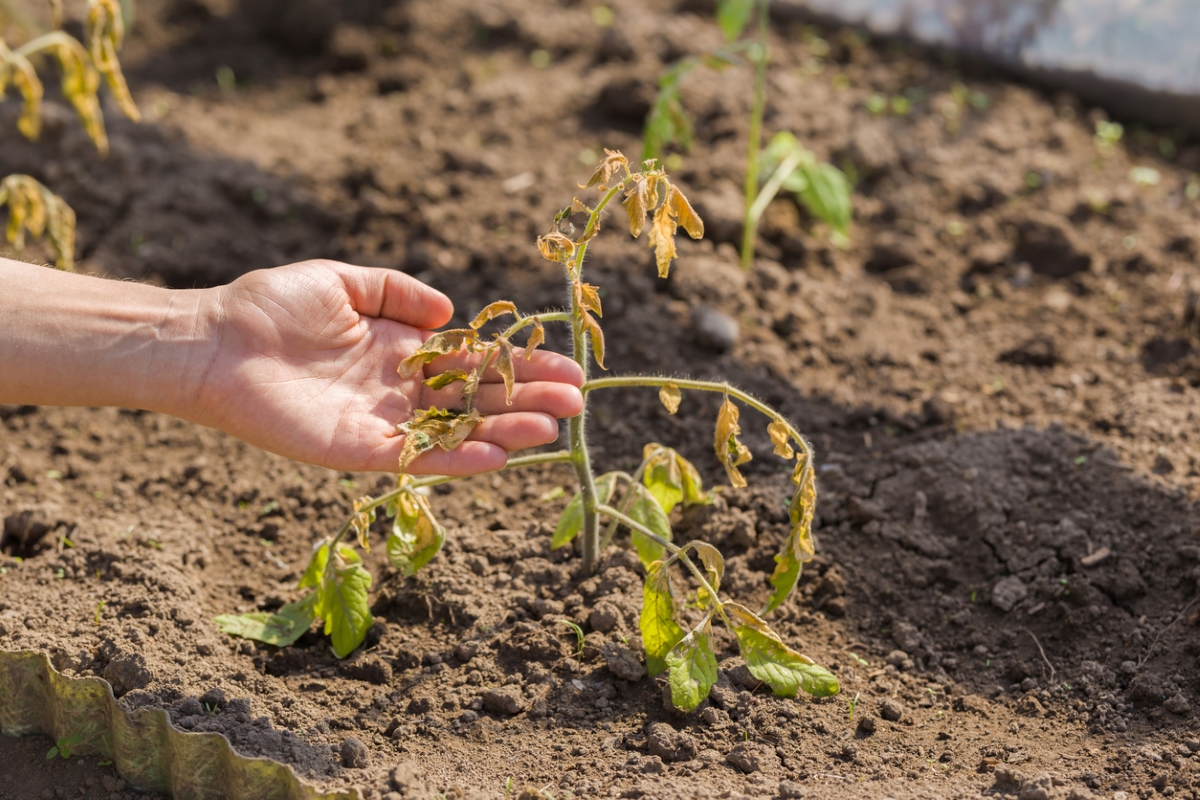
Potential Pests, Diseases, and Other Problems
Tomatoes are susceptible to several pests and diseases, such as aphids, cutworms, flea beetles, and hornworms. Tomato hornworms look like green caterpillars with white and black markings and a black protrusion at the rear (the horn). Tobacco hornworms are green with white stripes and V-shaped markings. Their “horn” is red. They both eat the leaves. The best way to get rid of them is to pick them off. Chickens love them. Parasitic insects such as wasps and ladybugs can also help control them.
Aphids are tiny white bugs that suck the sap from the underside of a plant’s leaves, causing them to curl and turn yellow and leading to stunted growth, black sooty mildew, and brown or black spots on stems and leaves. Insecticidal soap, neem oil, and parasitic wasps can eradicate them. Stop using insecticides when fruit sets.
Cutworms are small caterpillars often mistaken for grubs. They feed at night, cutting the stem just above the soil line, causing the plant to die. They also eat the fruit. Because cutworms burrow underground during the day, coming out at night to eat, the best way to protect your plants is to install aluminum foil or cardboard collars around them or extend a barrier into the ground.
Flea beetles are small, dark, shiny-coated bugs with long rear legs that allow them to jump like fleas. They leave multiple “shot holes” on young plants, producing a lacey effect. They can be repelled by sprinkling talcum powder on the plants or using sticky tape to capture them.
Blossom end rot occurs if the soil’s pH level is too low or it contains too much nitrogen. Uneven watering can also cause blossom end rot.
Blossom drop is caused by nighttime temperatures below 55 degrees Fahrenheit.
Early blight is a fungus caused by moldy residue in soil that is constantly wet. Leaves develop large, irregular spots with yellow halos.
Late blight is a fungus caused by water mold. Leaves develop large, dark brown blotches with gray edges. Fungicides and neem oil can treat both forms of blight.
Harvesting Tomatoes
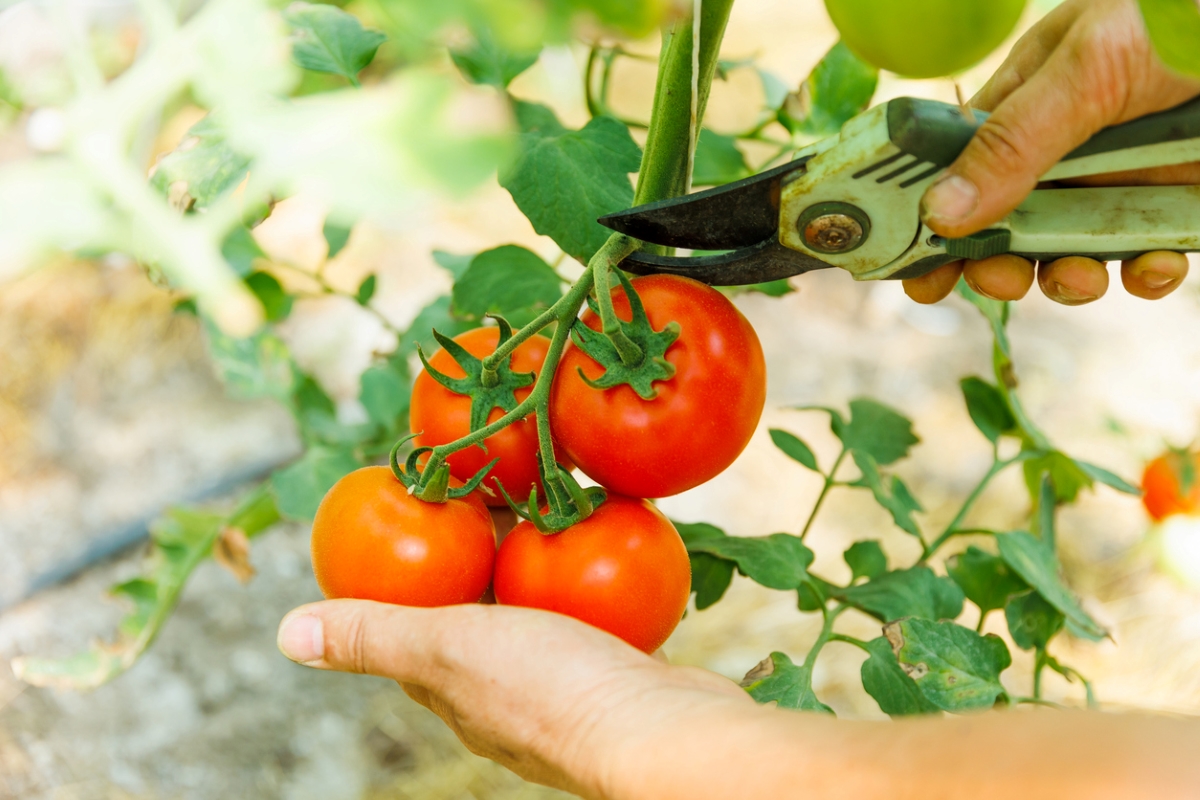
The tomato growing season is short, so it’s a good idea to keep an eye on developing fruit for harvest.
When is the best time to harvest tomatoes?
For the best vine-ripened flavor, pick tomatoes when they are firm and in full color. Note that they ripen best when the temperature is around 75 degrees Fahrenheit, but when it gets up to 90 degrees Fahrenheit, the fruit will soften and color development will be poor. Green tomatoes can be picked when they reach mature size and will ripen indoors.
How do you harvest tomatoes?
Letting tomatoes ripen on the vine will provide the best flavor, but if you’re growing a variety that tends to crack, you’ll want to harvest before their peak, when they’re just starting to come into their color. Either way, harvesting tomatoes is simple.
- Grasp the fruit firmly but gently in one hand while holding the stem in the other.
- Pull, breaking the stalk just above the calyx, which is the “hat” of small green leaves at the connection point of the fruit and the stalk.
- Alternatively, use scissors or pruners to cut the stalk.
How do you store tomatoes?
Store fresh tomatoes with the stems down (to prevent moisture escaping) on a plate or flat basket. A single layer prevents crushing of the delicate fruit. Keep them out of sunlight. Ideally, tomatoes should not be refrigerated, even after slicing. However, if you’re worried about them getting overripe, they’ll last a few days in the fridge.
Looking for more vegetable staples? Check out our guides on growing kale, sweet potatoes, and broccoli.
